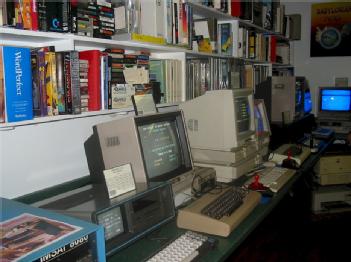
  |
Personal Computer Museum |
Chiuso |
N3R 2G1 Brantford, Canada (Ontario) |
| Indirizzo |
|
| Spazio espositivo | - purtroppo ancora non noto |
Computer / Informatic
- Media
|
Orario d'apertura
|
In 2018, the museum closed permanently following Bolton's death. At that time, it had been open to the public only one day a month. Its contents were transferred to University of Toronto Mississauga library in October 2020. | ||||
|
Status dal 10/2020
|
Closed Chiuso |
||||
| Contatti |
|
||||
| Pagina web | |||||
| Come arrivare |
Brantford is a city in Ontario, Canada, founded on the Grand River in Southwestern Ontario. The Personal Computer Museum was located in Brantford, Ontario, Canada, in a building formerly owned by the municipal government. The building was built with bricks reclaimed from the Brantford Opera House. |
| Descrizione | From Wikipedia, the free encyclopedia: The museum's mandate was to preserve computer technology and, more importantly, to offer interactivity with older machines. It welcomed private tours from schools and other groups. It was open to students, to study the origins of computers and the various technologies involved. Parents were welcome to bring children, to see computers which the parents may have once used, to get a sense of the ancestry of today's technology. Admission was free. The museum first opened to the public in September, 2005. It was run by Syd Bolton, its founder and curator, and by a group of dedicated volunteers. In 2018, the museum closed permanently following Bolton's death. At that time, it had been open to the public only one day a month. Its contents were transferred to University of Toronto Mississauga library in October 2020. Displays The downstairs showcased over 45 machines that were interactive. The most popular machines included the Commodore 64, IMSAI 8080 and Apple IIe. Video games and consoles were also represented. One rare Atari 2600 title was an "Extra Terrestrials" cartridge published in 1983 by a small Burlington, Ontario firm unaware of Atari's similarly themed 1982 'ET' game, a massive commercial failure which was a factor in the video game crash of 1983. There was a 1953 Admiral Black & White television downstairs connected to a game of Pong. The 'Tower of Power' was a 16-foot (4.9 m) high display that includes the original packaging for such machines as the Coleco Adam, Atari 2600, and Mattel Aquarius. Upstairs contained a magazine library that had classics such as Byte Magazine and Compute!. The library was home to over 4,000 publications. Upstairs also had a display known as 'Modem Alley' where the history of the modem was displayed including the major milestones contributed by manufacturers such as Hayes Microcomputer Products and Supra, Inc. Both levels included hundreds of books on various topics in computer history. A special section devoted to Canadian journalist and technology evangelist Jim Butterfield was on permanent display. Computer recycling The Personal Computer Museum engaged in computer recycling. Local residents would bring computers to the museum almost every Monday evening for safe, proper recycling. Computers that were still viable for redistribution were given away to needy families through the computer giveaway program. The museum also has an annual 'Spring Cleanup' event with a special focus on recycling that brought in over 400 pieces of electronics in 2008. |
[dsp_museum_detail.cfm]
| Conformità dei dati | Ulteriori informazioni |
